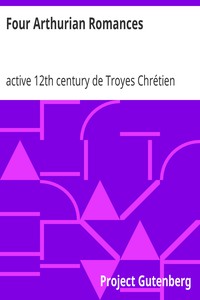Four Arthurian Romances, active 12th century de Troyes Chrétien [korean novels in english txt] 📗

Book online «Four Arthurian Romances, active 12th century de Troyes Chrétien [korean novels in english txt] 📗». Author active 12th century de Troyes Chrétien
35 (return)
[ This grotesque portrait of the "vilain" is perfectly conventional in aristocratic poetry, and is also applied to some Saracens in the epic poems. Cf. W.W. Comfort in "Pub. of the Modern Language Association of America", xxi. 494 f., and in "The Dublin Review", July 1911.]
36 (return)
[ For the description of the magic fountain, cf. W.A. Nitze, "The Fountain Defended" in "Modern Philology", vii. 145-164; G.L. Hamilton, "Storm-making Springs", etc., in "Romantic Review", ii. 355-375; A.F. Grimme in "Germania", xxxiii. 38; O.M. Johnston in "Transactions and Proceedings of the American Philological Association", xxxiii., p. lxxxiii. f.]
37 (return)
[ Eugen Kolbing, "Christian von Troyes Yvain und die Brandanuslegende" in "Ztsch. fur vergleichende Literaturgeschichte" (Neue Folge, xi. Brand, 1897), pp. 442-448, has pointed out other striking allusions in the Latin "Navigatio S. Brandans" (ed. Wahlund, Upsala, 1900) and elsewhere in Celtic legend to trees teeming with singing birds, in which the souls of the blessed are incorporated. A more general reference to trees, animated by the souls of the dead, is found in J.G. Frazer, "The Golden Bough" (2nd ed. 1900), vol. I., p. 178 f.]
38 (return)
[ Cf. A. Tobler in "Ztsch. fur romanische Philologie", iv. 80-85, who gives many other instances of boasting after meals. See next note.]
39 (return)
[ Noradin is the Sultan Nureddin Mahmud (reigned 1146-1173), a contemporary of the poet; Forre is a legendary Saracen king of Naples, mentioned in the epic poems (cf. E. Langlois, "Table des noms propres de toute nature compris dans les chansons de geste", Paris, 1904; Albert Counson, "Noms epiques entres dans le vocabulaire commun" in "Romanische Forschungen", xxiii. 401-413). These names are mentioned here in connection with the brave exploits which Christian knights, while in their cups, may boast that they will accomplish (F.). This practice of boasting was called indulging in "gabs" (=Eng. "gab"), a good instance of which will be found in "Le Voyage de Charlemagne a Jeruslaem" (ed. Koschwitz), v. 447 ff.]
310 (return)
[ It is evident in this passage that Chretien's version is not clear; the reader cannot be sure in what sort of an apartment Yvain is secreted. The passage is perfectly clear, however, in the Welsh "Owein", as shown by A.C.L. Brown in "Romanic Review", iii. 143-172, "On the Independent Character of the Welsh 'Owain'", where he argues convincingly for an original older than either the extant French of Welsh versions.]
311 (return)
[ The damsel's surprise and fright at the sight of Yvain, which puzzled Professor Foerster, is satisfactorily explained by J. Acher in "Ztsch. fur franzosische Sprache und Literatur", xxxv. 150.]
312 (return)
[ For magic rings, cf. A. Hertel, "Verzauberte Oertlichkeiten", etc. (Hanover, 1908); D.B. Easter, "The Magic Elements in the romans d'aventure and the romans bretons" (Baltimore, 1906).]
313 (return)
[ Much has been written on the widespread belief that a dead person's wounds would bleed afresh in the presence of his murderer. The passage in our text is interesting as being the earliest literary reference to the belief. Other instances will be found in Shakespear ("King Richard III., Act. I., Sc. 2), Cervantes ("Don Quixote"), Scott ("Ballads"), and Schiller ("Braut von Messina"). In the 15th and 16th centuries especially, the bleeding of the dead became in Italy, Germany, France, and Spain an absolute or contributory proof of guilt in the eyes of the law. The suspected culprit might be subjected to this ordeal as part of the inquisitional method to determine guilt. For theories of the origin of this belief and of its use in legal trials, as well as for more extended bibliography, cf. Karl Lehmann in "Germanistische Abhandlungen fur Konrad von Maurer" (Gottingen, 1893), pp. 21-45; C.V. Christensen, "Baareproven" (Copenhagen, 1900).]
314 (return)
[ W.L. Holland in his note for this passage recalls Schiller's "Jungfrau von Orleans", Act III. Sc. 7, and Shakespeare, first part of "King Henry IV.", Act V. Sc. 4:
315 (return)
[ Foerster regards this excuse for Kay's defeat as ironical.]
316 (return)
[ It is hoped that the following passage may have retained in the translation some of the gay animation which clothes this description of a royal entry into a mediaeval town.]
317 (return)
[ This idea forms the dominating motive, it will be recalled, in "Erec et Enide" (cf. note to "Erec", v. 2576).]
318 (return)
[ The parallel between Yvain's and Roland's madness will occur to readers of Ariosto's "Orlando Furioso", though in the former case Yvain's madness seems to be rather a retribution for his failure to keep his promise, while Roland's madness arises from excess of love.]
319 (return)
[ Argonne is the name of a hilly and well-wooded district in the north-east of France, lying between the Meuse and the Aisne.]
320 (return)
[ An allusion to the well-known epic tradition embodied in the "Chanson de Roland". It was common for mediaeval poets to give names to both the horses and the swords of their heroes.]
321 (return)
[ For the faithful lion in the Latin bestiaries and mediaeval romances, see the long note of W.L. Holland, "Chretien von Troies" (Tubingen, 1854), p. 161 f., and G. Baist in Zeitschrift fur romanische Philologie, xxi. 402-405. To the examples there cited may be added the episodes in "Octavian" (15th century), published in the "Romanische Bibliothek" (Heilbronn, 1883).]





Comments (0)